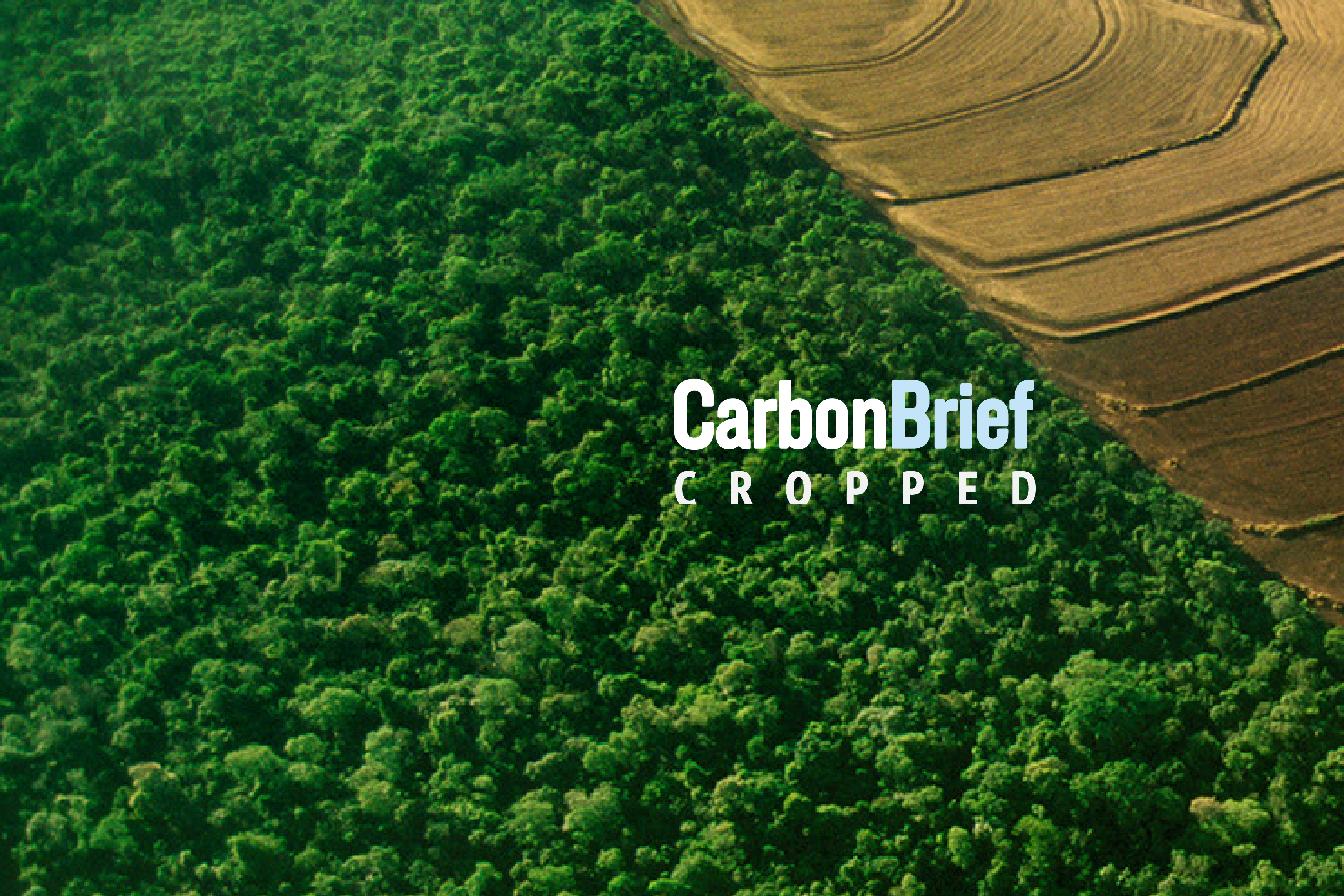Welcome to Carbon Brief’s Cropped.
We handpick and explain the most important stories at the intersection of climate, land, food and nature over the past fortnight.
This is an online version of Carbon Brief’s fortnightly Cropped email newsletter. Subscribe for free here.
Weather drives food price spike
BITTER TRUTHS: Cocoa futures contracts being traded on the New York commodities exchange “hit an all-time high above $12,000 per tonne in April”, but fell below $9,000 this week “on the news of rains arriving in west Africa”, the Financial Times reported. The “wild swings” that are “enough to be bankrupting for a lot of people” are “a sign of market volatility and stress following successive poor harvests in Ivory Coast and Ghana” – the world’s two top producers of cocoa. Both countries, along with Nigeria and Cameroon, “have seen drastically reduced crop yields amid droughts, fires and other climate change-induced weather phenomena”, African Business reported, further “exacerbated by decades of underinvestment in the sector”. Farmers are having to “pursue alternative revenue streams”, the outlet added. The crisis facing the cocoa sector points to a systemic problem, the Guardian wrote: “Faced with global heating, increasing conflict and energy price instability, depending on the free market is a poor bet.”
-
Sign up to Carbon Brief’s free “Cropped” email newsletter. A fortnightly digest of food, land and nature news and views. Sent to your inbox every other Wednesday.
‘HEATFLATION’: A global olive oil shortage brought on by drought and extreme heat in Europe has driven prices to record highs and even “fuelled a crime surge”, CNBC News reported. Spain, the world’s largest olive supplier, saw output cut between 30-50% of its usual 1.3m-tonne harvest, with Spanish supermarkets reporting that “olive oil had become the most stolen item” across the country, the story added. Helena Bennett at policy thinktank Green Alliance UK “unequivocally attributed the record spike in olive oil prices to climate change”, telling CNBC: “It’s happening to other food crops too…Olive oil today, everything else soon.” The experts who predicted last year that “heatflation” would send olive oil price’s skyrocketing “were right”, Salon wrote.
‘SOGFLATION’: Meanwhile, the UK is staring at the costs of “sogflation”, according to Bloomberg. Bread, beer and biscuit prices “look set to rise sharply” after a wet winter impacted crops across the UK, according to new analysis by the Energy and Climate Intelligence Unit (ECIU), the Press Association reported. According to ECIU, yields of key crops such as wheat, barley, oats and rapeseed “might drop by 4m tonnes” compared to 2023, with wheat slated to see a 27% drop. Between October 2022 and March 2024, England experienced “the wettest 18-month period since records began in 1836”, the Guardian said, resulting in “crops either being flooded[,] damaged…or farmers not being able to establish crops at all.”
Hotter ocean, burning mountains
MARINE HEATWAVES: The Indian Ocean “is experiencing unprecedented and accelerated warming” and could hit a rate of 1.7-3.8C per century “unless greenhouse gas [emissions] are reduced immediately”, Down to Earth wrote, reporting on new research. The work – which forms the chapter of a new book – found that marine heatwave days “are expected to rise” from 20 to 220-250 a year, meaning that “most of the Indian Ocean could be in a near-permanent state of marine heatwave conditions”, the story said. This could cause tropical cyclones to intensify rapidly, “putting fisheries and people living along the coastline at risk”, Mongabay wrote, reporting on the same study.
LAKSHADWEEP LOSS: The Hindu reported that researchers at India’s Central Marine Fisheries Research Institute (CMFRI) recorded “widespread bleaching impacting coral reefs in the Lakshadweep Sea owing to marine heatwaves” this week. Since October last year, the Lakshadweep Sea – bordering India, Maldives and Sri Lanka – saw temperature “rises greater than 1C”, CMFRI scientists told the paper. “If the situation continues to rise, it could precipitate an unprecedented biodiversity crisis due to multispecies mortality,” said Dr KR Sreenath, senior scientist at the CMFRI. “The degradation of these ecosystems can lead to the collapse of local marine food webs, affecting a wide range of marine species, from fish communities to marine mammals like dugongs and dolphins,” he added.
FIRE IN THE MOUNTAIN: Meanwhile, on land, India reported a record 75,000 forest fires in April, according to the Hindustan Times. The eastern states of Odisha and Chhattisgarh and the Himalayan state of Uttarakhand were among the worst affected, with a senior forest official telling the paper that a “warmer-than-usual April and drier winter this year are the reasons for sudden spurt”. The mountainous state of Uttarakhand lost more than 142 hectares of forest to fires in just 72 hours, with “scanty winter rain” playing a major role in the 6,701 blazes that broke out in the hill state last month, another Hindustan Times story reported. A NewsLaundry investigation reported that Uttarakhand’s district authorities “ignored” warnings and deployed nearly all of their forest staff and vehicles for election duty during peak fire season, affecting “official preparedness to deal with the [fires]”.
Nature loss and climate change fuelling infectious diseases
In this spotlight, Carbon Brief reports on a new study finding that biodiversity loss is the largest driver of infectious diseases, with climate change, pollution and invasive species also increasing outbreak risks.
The role of environmental problems, such as climate change and biodiversity loss, in spreading infectious diseases to humans and animals has received renewed focus since the onset of the Covid-19 pandemic.
The root cause of the pandemic has never been identified, but some researchers suspect that the virus passed from bats to humans through an unknown intermediary animal, possibly a pangolin.
An infection or disease that has passed from an animal to a human is known as a “zoonosis”. Back in 2020, a range of scientists told Carbon Brief that such events could be increasing because of climate change, biodiversity loss and habitat destruction, which are each creating new opportunities for humans and animals to come into contact.
A new study in Nature conducted a meta-analysis of the available scientific literature to try to understand what the main global drivers of infectious disease risk could be for both humans and wildlife.
Data crunching
For the research, the scientists identified studies on the links between infectious disease and environmental change, a category that included biodiversity loss, chemical pollution, climate change, habitat loss or change and invasive alien species.
They extracted the relevant data from these studies to create a database detailing nearly 3,000 observations of infectious disease spread or harm in response to environmental change.
The next step was to standardise the data so that they could compare how different environmental change drivers affect infectious disease risk.
The results showed that biodiversity loss was the largest driver of infectious disease risk across the studies included in the database, co-lead author Prof Jason Rohr, an ecology and public health researcher at the University of Notre Dame in the US, told Carbon Brief:
“Biodiversity loss, climate change and alien species tend to increase infections, and urbanisation tends to decrease infections. These results were generally consistent across human and non-human diseases.”
Disease surveillance
The results could help policymakers to channel financial resources for tackling infectious diseases more effectively, Rohr said:
“The findings [we] uncovered should help target disease management and surveillance efforts towards global change drivers that increase disease.
“Specifically, reducing greenhouse gas emissions, managing ecosystem health and preventing biological invasions and biodiversity loss could help to reduce the burden of plant, animal and human diseases, especially when coupled with improvements to social and economic determinants of health.”
MAASAI MAROONED: Forty tourists and staff members marooned in Kenya’s Maasai Mara Game Reserve due to flooding were rescued by local authorities, the Star reported. Dozens “narrowly escaped death at dawn” when the Talek River, which runs through the park, burst its banks after “torrential” rains, the East African reported. The outlet added that visitors and workers were “forced to climb trees” after the camps became waterlogged. At least 11 people have died due to the floods in Narok and Bomet counties, the Nation said. Gazelles and giraffes were the most affected wild animals, with the floods “disrupting habitats, food sources and water availability”.
EARTH ANGELS: Seven environmental defenders from six different continents were awarded this year’s Goldman Prize. Widely described as the “green Nobel”, the prize is given out to campaigners for “sustained and significant” efforts to protect the environment, Reuters wrote, profiling India’s Alok Shukla and his role in the decade-long movement to protect the Hasdeo Arand forest from coal mining. Marcel Gomes, executive secretary at Repórter Brasil, won the prize for coordinating an international investigation that “pressured big European retailers to stop selling illegally sourced” beef, Mongabay reported. Other winners this year include Murrawah Johnson from Australia’s First Nations, Nonhle Mbuthuma from South Africa and Spain’s Teresa Vincente.
NICKEL FOR FORESTS: According to a Global Forest Watch report, primary forest loss in Indonesia increased by 27% in 2023 compared to the previous year, the Associated Press reported. While the report said this loss is “still seen as historically low compared to the 2010s”, some experts “saw concern in the recent uptick”, tying it to the “world’s appetite for mining Indonesia’s vast deposits of nickel, which is critical for the green energy transition”, the newswire wrote. AP added that Global Forest Watch’s data on deforestation is “higher” than official Indonesian figures.
BRAZIL FLOODS: Storms and flooding in the southern Brazilian state of Rio Grande do Sul have killed at least 78 people and displaced a further 115,000 people, Al Jazeera reported. The floods have caused damage to roads and bridges, triggered landslides and caused the partial collapse of a dam at a small hydroelectric power plant, the outlet noted. A second dam in the area is also at risk of collapsing due to rising water levels, according to BBC News. It added that the extreme weather has been caused by “a rare combination of hotter than average temperatures, high humidity and strong winds”.
G7 MEETING: A meeting of ministers from the G7 – Canada, France, Germany, Italy, Japan, the UK and the US – in Turin saw countries restate and add detail to climate, energy and biodiversity commitments. Along with a much-publicised pledge to end new coal power by 2035, the G7 also committed to a “swift, full and effective implementation” of the Kunming-Montreal Global Biodiversity Framework (GBF) and to submit new national biodiversity plans ahead of the COP16 biodiversity summit in October. (France and Japan are the only G7 nations to have submitted plans so far and the US is not party to the UN biodiversity convention.) The G7 also said it would hold a workshop on implementing the GBF, with a focus on invasive species.
‘FIELDS OF FILTH’: Intensive meat and dairy farms in England have breached environmental regulations thousands of times in the past few years, according to a new investigation by the Bureau of Investigative Journalism. The organisation obtained investigation records from England’s Environment Agency describing more than 3,000 incidents, including “routine discharge of slurry and dirty water, maggot-infested carcass bins and the illegal incineration of pigs”. An Environment Agency spokesperson told the publication that there was a clear need for improvement, noting that around 80% of pig and poultry farm inspections resulted in advice and guidance, 16% resulted in a warning and around 2% resulted in a formal caution or prosecution.
RESTORATION RETHINK: Dr Forrest Fleischman gave a talk at the Leverhulme Centre for Nature Recovery on the relationship between ecosystem restoration and social science, as large-scale restoration projects gain more traction as a climate solution.
OFFSETS INVESTIGATED: The BBC’s flagship investigations show Panorama exposed serious issues with company net-zero claims that rely on carbon offsets.
KILLER GANG: A Mongabay story reported on how a single poaching ring may have “wip[ed] out 10% of the entire global population of the critically endangered” Javan rhino.
SEDIMENT STRATEGY: A deep dive in Nature unpacked Maldives’ “race” to reclaim land from the sea to combat sea level rise, but critics say the environmental costs are too high.
Asymmetric impacts of forest gain and loss on tropical land surface temperature
Nature Geoscience
A new study found that land-surface warming caused by tropical forest loss is stronger than the cooling produced by forest gain – a significant finding, since tree-planting is often viewed as a key climate solution. The authors used multiple sources of satellite data to understand how land temperatures responded to forest loss and gain, finding that loss caused warming of about 0.56C and afforestation only brought down temperatures by around 0.10C. This asymmetry has not been captured by current Earth-system models and “could overestimate the cooling effect of afforestation in future”, the authors said.
Global trends and scenarios for terrestrial biodiversity and ecosystem services from 1900 to 2050
Science
Climate change could become the largest driver of biodiversity loss by the middle of the century, new research suggested. The study used modelling to examine past and future drivers of global biodiversity loss. It found that during the 20th century, global biodiversity declined by 2-11%, with land-use change as the major driver. However, projections for the future suggested that climate change is likely to overtake land-use change to become the biggest driver by mid-century, especially under high emissions scenarios, the researchers said. They added that the findings “robustly show that renewed policy efforts are needed to meet the goals of the Convention on Biological Diversity”.
The positive impact of conservation action
Science
New research found that conservation actions improved the state of biodiversity – or at least slowed down biodiversity loss – but did not halt it “more than half of the time”. Researchers conducted a meta-analysis of 186 studies that measured biodiversity over time and contrasted conservation outcomes against areas where there were no measures in place to protect nature. Of all the conservation actions studied, invasive species control, habitat loss reduction and restoration, creation of protected areas and sustainable management had the highest impact. The authors concluded: “Conservation actions are investments rather than payments – and, as our study demonstrates, they are typically investments that yield genuine, high-magnitude positive impacts.”
Cropped is researched and written by Dr Giuliana Viglione, Aruna Chandrasekhar, Daisy Dunne, Orla Dwyer and Yanine Quiroz. Please send tips and feedback to [email protected].
Sharelines from this story




















Discussion about this post